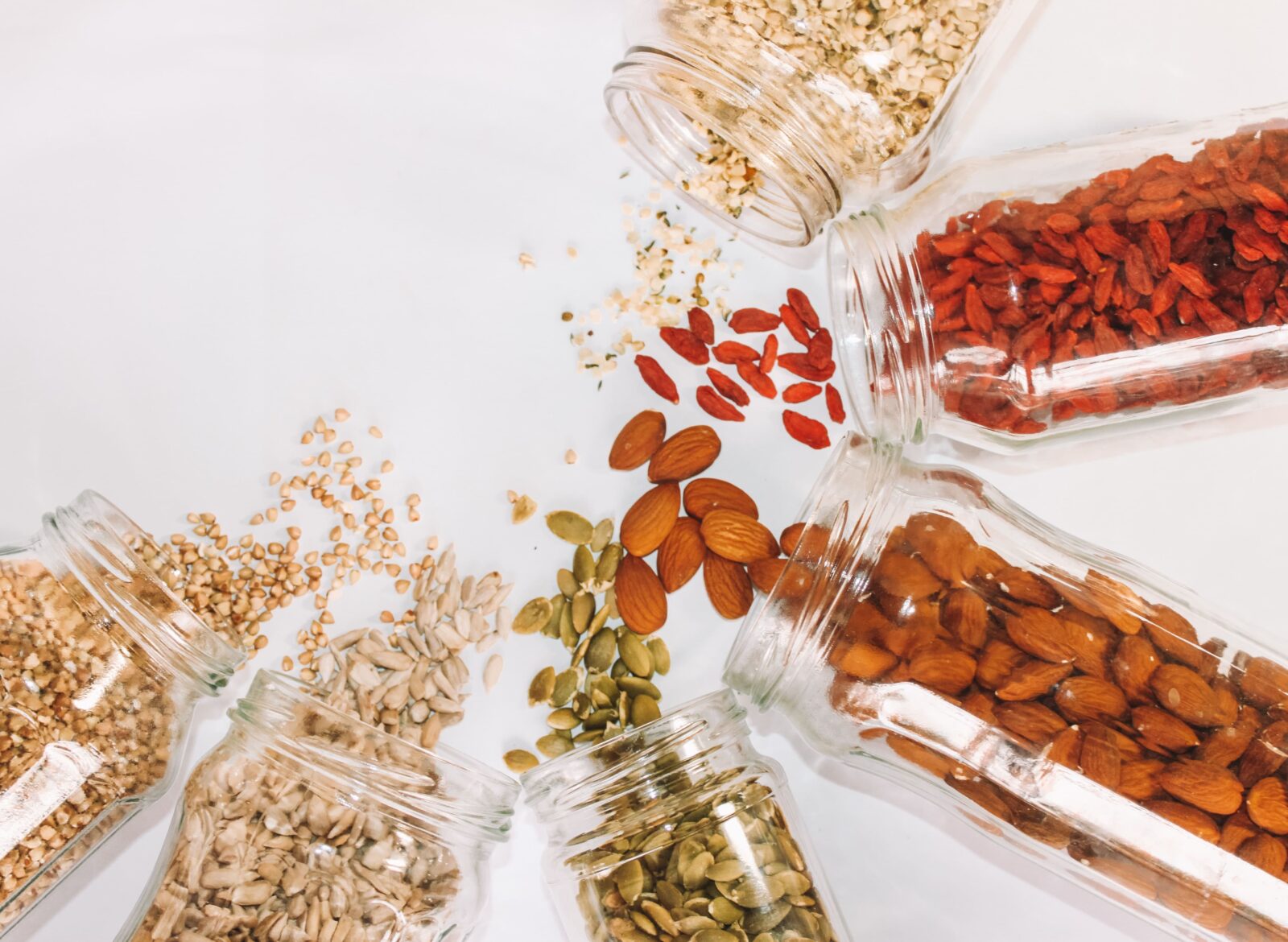Last updated on April 17th, 2023 at 02:33 pm
We have already established that minerals are vital for optimal health. Furthermore, they form one of the pillars of health, and the body can’t make them, so you have to eat various nutrient-dense real foods to maintain a healthy mineral status. Now this article forms a little guide that explores the different types of minerals, mineral-rich food sources, and mineral functions.
The first thing to remember, there are many types of minerals with clinical uses and symptoms of deficiency and toxicity. Secondly, mineral-rich food sources are easy to incorporate into your everyday eating. Lastly, mineral functions play an essential role in overall health and wellness.
I thought it would be fun and educational to break this into a simple yet comprehensive guide.

Here is a list of some of the different types of minerals for health and wellness
MACROMINERALS
Macrominerals, also called major minerals, are all the types of minerals the body needs in more significant amounts for correct function. Here is a mineral list of all the macrominerals for healthy function.
Calcium
Calcium is the most abundant mineral in the body, making up at least 1.5-2.0% of the body by weight. Most importantly, the body’s calcium stores are the bones and teeth. Also, calcium metabolism is closely related to vitamin D. Not to mention; two hormones regulate calcium:
- Calcitonin – decreased serum calcium by increasing calcium deposition in bone and decreasing calcium absorption.
- Parathyroid Hormone – raises serum calcium by causing calcium resorption and increasing calcium absorption in the gut.
Mineral functions of calcium:
- plays a significant part in the structure of bones and teeth
- calcium ions add hardness to the bone matrix
- facilitates the movement of nutrients across cell membranes (a requirement for neurotransmitter activity)
- required by the heart for proper contraction
- initiates the clotting process
Clinical uses of calcium:
Osteoporosis, high cholesterol, high blood pressure, blood clotting, periodontal disease, muscle relaxant, insomnia, and treatment of kidney stones (particularly as calcium citrate.)
Symptoms of calcium deficiency:
- osteoporosis
- muscle cramps and tetany
- periodontal disease
- hyperactivity
- anxiety
- insomnia
Calcium toxicity:
Excess calcium supplementation can cause imbalances with other minerals, particularly magnesium.
Mineral-rich food sources:
raw dairy, cooked leafy greens (collard greens, spinach, turnip greens), yeast, lamb, sardines, rhubarb, and soaked or sprouted oatmeal.
Magnesium
Magnesium is a predominantly intracellular mineral. Additionally, it facilitates as many as 300 enzymatic reactions. Not to mention, 60% of magnesium in the body is in the bones, 25% in muscle, and the remainder in the fluids and soft tissue. Moreover, it is also present in high concentrations in the mitochondria and the heart.
Mineral functions of magnesium
- plays a role in the structural integrity of teeth and bones
- regulates contractility of heart muscles
- relaxes smooth muscles
- decreases coagulation of the blood
- necessary for essential fatty acid metabolism
- essential for protein synthesis
- used to produce urea in the urea cycle in the liver
- along with vitamin B6, it is helpful for the prevention of kidney stones
Clinical uses of magnesium:
Constipation, muscle cramping – mainly nocturnal, acute angina or after myocardial infarction, kidney stone prevention, PMS, menstrual cramps, heart disease – arrhythmia, hypertension, migraines.
Symptoms of magnesium deficiency:
Magnesium deficiency is prevalent in the United States due to the significant processing of food (and all the added sugar), soil depletion, and exogenous estrogens such as birth control pills and H.R.T.
- muscle spasms and tightness
- painful menstrual cramps
- high blood pressure
- heart arrhythmias
- increased blood triglyceride and cholesterol
- nerve conduction problems
Magnesium toxicity:
Excess magnesium supplementation can cause diarrhea (800mg of elemental magnesium will cause loose stool.) Furthermore, magnesium competes with calcium and can lead to calcium deficiency. Most important, individuals with kidney failure should be careful not to take too much magnesium due to its potential toxicity.
Mineral-rich food sources:
soaked or sprouted buckwheat, fermented whole wheat, soaked or sprouted almonds, wheat gem, soaked or sprouted cashews, soaked or sprouted brown rice, and soaked or sprouted kidney beans.
Of all the minerals, most people are highly deficient in magnesium. It is one of the few “blanket statement” supplementation recommendations I will make. Everyone needs to support their bodies with additional magnesium supplementation. A super (and relaxing) way to increase magnesium stores in the body is to take a magnesium salt bath for 20-25 minutes. This lotion is also a great option to increase magnesium levels topically. I always recommend getting various kinds of magnesium when supplementing – I love Smidge Morning and Evening Magnesium (available on my Fullscript dispensary) and this liquid form.

Phosphorus
Phosphorus is the second most abundant mineral in the body after calcium. Additionally, 8% of phosphorus in the body is in the form of calcium phosphate crystals in the bone and teeth. Also, the parathyroid is responsible for maintaining phosphorus levels in the body. Moreover, a 1:1 intake of calcium to phosphorus is ideal for maximum calcium absorption. As a result of the Western diet, we consume twice as much phosphorus as we need. As a matter of fact, the primary source of phosphorus in the Western diet comes from carbonated beverages and food additives.
Mineral functions of phosphorus:
- is a structural component of teeth and bones
- an essential component of nucleic acids of DNA and phospholipids that make up cellular membranes
- a necessary part of Adenosine Tri-Phosphate (ATP), the primary energy compound in the body
- an essential component of many structural proteins – casein in human milk
- involved in acid-base buffering as part of the calcium phosphate buffering system
Clinical uses of phosphorus:
Helpful in treating acute parasympathetic symptoms, particularly nausea, and gallstones.
Symptoms of phosphorus deficiency:
Phosphorus is so abundant in Western diets that deficiency is uncommon. However, it may occur with the use of antacids (which may bind phosphorus), alcoholism, during treatment of diabetic acidosis, and with specific vegetarian diets.
Phosphorus toxicity:
Excess phosphorus can inhibit calcium absorption and lead to problems with osteoporosis. In this case, it can also leach calcium from bones and teeth.
Mineral-rich food sources:
Chicken, turkey, pork, raw dairy, soaked or sprouted sunflower seeds, soaked or sprouted pumpkin seeds, and soaked or sprouted nuts.
Potassium
Potassium is one of the significant intracellular minerals and electrolytes and actively transports in and out of the cell. However, increased aldosterone levels (an adrenal gland hormone) cause potassium excretion from the body. To sum up, the body excretes potassium under the influence of many diuretic drugs.
Mineral functions of potassium:
- one of the major transport systems in the body via the sodium-potassium pump
- functions to maintain proper cellular fluid levels
- acid-base balance in the body
- needed for nerve conduction
- essential for heart function
Clinical uses of potassium:
High blood pressure, abnormal heartbeat, and atherosclerosis.
Symptoms of potassium deficiency:
Many people are deficient in potassium, which often leaches out of food due to its water-soluble nature.
- fatigue
- mental confusion
- muscle weakness and cramping
- cardiovascular problems
Potassium toxicity:
Potassium toxicity comes mostly in supplemental form. In short, signs and symptoms include; nausea, vomiting, and diarrhea. Also, abnormal heartbeats may indicate potassium excess due to potassium’s effect on the heart.
Mineral-rich food sources:
Avocados, apricots, potatoes, canteloupe, lima beans, parsnips, raisins, and sardines.

MICROMINERALS
Microminerals, also called trace minerals, are all the minerals the body needs in trace or small amounts for correct function. Here is a mineral list of all the microminerals required for healthy function.
Iron
Did you know the body stores 1/3 of iron in the liver, spleen, and bone marrow? As a result, the remaining 2/3 is in hemoglobin and myoglobin. Moreover, iron exists in two forms:
- heme-iron is more bio-available and absorbable, and the primary source is meat. Also, once digested, it is directly absorbed into the bloodstream.
- non-heme-iron is present in animal and plant products. However, it must be removed from the food source, converted into the ferrous form of iron (a process that requires stomach acid and vitamin C), and joined to an amino acid before absorption.
Mineral functions of iron:
- is transported in the body by a carrier protein called transferrin
- stored in the body as ferritin, which is a marker of long-term iron stores in the body
- iron is the major component of heme, the main part of hemoglobin. This molecule carries oxygen and carbon dioxide in red blood cells.
Clinical uses of iron:
Treatment of iron deficiency anemia, decreased immune function, and restless leg syndrome.
Symptoms of iron deficiency:
Firstly, iron deficiency causes anemia. Secondly, the causes of iron-deficiency anemia include decreased intake of iron, insufficient levels of stomach acid, blood loss (externally and internally), and excess menstrual bleeding are common causes of iron deficiency anemia in women.
- a sense of fatigue and being overly tired or drowsy
- weakness
- breathlessness
- coldness in extremities
- pallor
- swollen tongue
- spooning of nails
Symptoms of iron toxicity:
Excess iron can cause iron deposition in the tissues, which can cause tissue damage. Also, 10% of the population has a genetic problem where iron is deposited in the tissues, especially the liver. Did you know iron toxicity is more common in men? Because they do not have a regular means of excreting iron. Synthetic vitamin C (ascorbate) can lead to excess iron by enhancing iron absorption.
Mineral-rich food sources:
Beef liver, molasses, amaranth, beef, seaweed, cooked leafy greens (chard, collard greens, mustard green), oysters, and soaked or sprouted lentils.
If the thought of eating beef liver is just too much, desiccated beef liver capsules can be a great choice.
Zinc
Zinc is a significant part of hundreds of enzyme systems in the body. Also, no functional stores of zinc exist. However, a small amount is locked in muscle, spleen, bone marrow, liver, and enzyme complexes. Moreover, red and white blood cells have a high concentration of zinc. As a result, zinc requires adequate stomach acid for absorption. Another key point is that iron, copper, and phytates inhibit zinc absorption.
Mineral functions of zinc:
- essential for the production of stomach acid
- necessary for the synthesis of cholesterol, fats, and proteins
- regulate the release of vitamin A from the liver
- critical for cell growth and cellular replication of DNA
- essential for protein synthesis and skin and bone integrity
- necessary for the health of the prostate
- the immune system needs zinc for optimal function
- cofactor in essential fatty acid metabolism and synthesis
- needed for taste perception
Clinical uses of zinc:
Skin disorders, acne, prostate problems, infertility, macular degeneration, and immune enhancement.
Symptoms of zinc deficiency:
Zinc deficiency is a widespread problem.
- growth retardation
- loss of smell and taste perception
- reduced immunity
- delayed wound healing
- reproductive difficulties
- loss of appetite
- skin disorders
- white spots on the fingernails
Zinc toxicity:
Zinc supplementation in doses greater than 20 mg on an empty stomach may lead to nausea and stomach upset. However, this is more common in those with low stomach acid. Furthermore, long-term zinc supplementation in doses greater than 50 mg/day may lead to copper deficiency.
Mineral-rich food sources:
Oysters, beef, wheat gem, turkey, raw cheese, cooked swiss chard, lima beans, potato, soaked or sprouted oats.
If the thought of eating oysters is just too much, you can supplement with a whole-food oyster supplement. I recommend Smidge, available at my Fullscript dispensary.

Copper
Copper is a constituent of the brain, heart, teeth, kidney, and liver. Although it is absorbed through the stomach and small intestine, only half of the ingested copper gets absorbed. Even so, copper is also excreted via bile.
Mineral functions of copper:
- a cofactor in several enzyme complexes
- needed for the conversion of dopamine into the neurotransmitter norepinephrine
- essential for the repair and synthesis of connective tissue
- used in the breakdown of estrogen in the liver
- anti-inflammatory activity
- needed for the mobilization of iron from the liver
- required for adrenal function
Clinical uses of copper:
Anemia, enchanting immunity, and prevention of aneurysms.
Symptoms of copper deficiency:
Copper deficiency can be caused by a genetic inability to absorb copper in the intestines and adrenal hypo-function.
- breakdown of blood cells
- anemia
- lowered white blood cell count
- de-pigmentation of the skin
Copper toxicity:
Copper supplementation may cause nausea and vomiting. Even more, long-term supplementation may cause liver cirrhosis. Both copper cookware and old copper plumbing may increase the chances of copper toxicity.
Mineral-rich food sources:
beef, beef liver, rye, soaked or sprouted beans, soaked brazil nuts, soaked or sprouted cashews, peas, molasses, soaked or sprouted sunflower seeds.
If the thought of eating beef liver is just too much, desiccated beef liver capsules can be a great choice.
Chromium
Chromium is found in an inorganic and organic form. In brief, inorganic forms are poorly absorbed, and only 25% of organic chromium is absorbed. In addition, chromium uses amino acids and other nutrients for absorption. Moreover, it is transported to the liver by transferrin. In general, a high intake of refined sugar can increase levels of chromium in the blood.
Minerals functions of chromium:
- an essential nutrient for blood sugar regulation
- a critical component of the Glucose Tolerance Factor (GTF), which helps bind to the appropriate receptor on the cell surface
- functions in fat, protein, and carbohydrate metabolism
Clinical uses of chromium:
Blood sugar dysregulation, prevention of atherosclerotic plaques, increased cholesterol levels, and acne.
Symptoms of chromium deficiency:
Chromium deficiency is expected in the United States due to poor availability and difficulty in absorption. As I have noted, a large intake of sugar and refined carbohydrates can increase chromium needs.
- blood sugar dysregulation
Chromium toxicity:
No toxicity for chromium has been established.
Mineral-rich food sources:
Brewer’s yeast, oysters, liver, seafood, soaked or sprouted whole grains, raw cheese, potatoes, and chicken.
If the thought of eating beef liver or oysters is just too much, desiccated beef liver capsules or a whole-food oyster supplement can be a great choice. I recommend OysterZinc by Smidge, available at my Fullscript dispensary.
Selenium
Once thought toxic, selenium has many uses in human metabolism. Did you know selenium is more accessible to humans in plant form than animal form? Moreover, it is found in organic and inorganic forms with different properties. As a result, organic selenium synthesizes glutathione peroxidase, an essential antioxidant in the body.
Mineral functions of selenium:
- essential for the production of glutathione peroxidase
- inhibits certain types of cancer
- necessary for sexual function
Clinical uses of selenium:
Prevention of cancer, arthritis, allergy desensitization, detoxification, cardiovascular disease, heavy metal toxicity, eye disorders (cataracts and macular degeneration), and prevention of viral illness.
Symptoms of selenium deficiency:
Selenium deficiency is becoming widespread due to soil depletion and the processed nature of our food supply. Additionally, certain diseases associated with low soil selenium include; cardiomyopathy and arthritis.
- painful muscles
- anemia
- growth retardation
- cardiovascular issues
Selenium toxicity:
Selenium can be toxic in prolonged doses above 800mcg/day. After all, it has a narrow therapeutic dosage range and margin of safety. As a result, symptoms of toxicity include; a metallic taste in the mouth, damage to fingernails, depression, nervousness, mental instability, garlic smell to sweat and breath, GI irritation, and hair loss.
Mineral-rich food sources:
Soaked brazil nuts, seafood, cooked swiss chard, soaked or sprouted oatmeal, freshly squeezed orange juice, wheat gem, molasses, and soaked or sprouted sunflower seeds.

Iodine
Iodine is stored primarily stored in the thyroid gland. For one thing, it is easily absorbed and found in the serum in a protein-bound and free form. Furthermore, iodine bound to another compound or molecule is called iodide. In summary, free and unbound iodine is called iodine.
Mineral functions of iodine:
- is essential for the synthesis of thyroxine, the active hormone produced by the thyroid gland
- essential for estrogen metabolism in breast tissue
- helps in the conversion of various types of estrogen
Clinical uses of iodine:
Treating goiter, hypothyroidism, fibrocystic breast tissue, lymph stasis, antiviral, bacterial, and fungal activity, estrogen metabolism, and calcium mobilization.
Symptoms of iodine deficiency:
Iodine deficiency is a worldwide problem, despite the availability of iodized salt. Not to mention, certain foods block the absorption and utilization of iodine. In short, these foods are known as goitrogens: broccoli, cabbage, peanuts, turnips, etc.
- delayed development of cretinism
- hypothyroidism
- swollen thyroid gland, or goiter
Iodine toxicity:
Iodine toxicity is known as iodism and may be brought on by topical application or ingestion. In this case, symptoms include; increased heart rate, skin irritation, thinning secretions, nervousness, and headaches. Generally, there is a wide range of safety, but high doses for an extended time (20-30 mg/day) may suppress thyroid function.
Mineral-rich food sources:
Sea salt, seaweed (kombu, dulse, and kelp), seafood (haddock, cod, and shrimp.)
Boron
Boron is concentrated in the thyroid gland and has low levels in the serum. For the most part, it is used in many bodily functions.
Mineral functions of boron:
- essential for the process of hydroxylation in the body, a process in bone metabolism
- enhances the metabolism of steroid hormones, including testosterone, estrogen, and DHEA
- necessary for the conversion of vitamin D into its active form of 1.25 dihydroxycholecalciferol
- useful in cell membrane function
Clinical uses of boron:
Osteoporosis and osteoarthritis.
Symptoms of boron deficiency:
- certain types of arthritis.
Boron toxicity:
Very little toxicity is associated with boron.
Mineral-rich food sources:
Tomatoes, peanuts, dates, raisins, soaked or sprouted hazelnuts, apples, and prunes.
Manganese
Manganese is found in the highest concentrations in the mitochondria. In brief, it is not easily absorbed, with less than 1% of dietary intake being absorbed. Moreover, it depends on healthy biliary function (gallbladder) for uptake.
Mineral functions of manganese:
- is used in several different enzyme complexes
- needed for connective tissue and bone development, especially the skin, skeleton, and small bones of the ear
- utilized during situations for bone remodeling (like after a fracture)
- essential for healthy pancreatic function
- used in the synthesis of cholesterol and fatty acids
- aids in the utilization of choline
Clinical uses of manganese:
Non-toxic goiter, ligament and disc support, viral infection, immune support, carbohydrate sensitivity, bone repair, and arthritis.
Symptoms of manganese deficiency:
- fat and carbohydrate synthesis problems
- glucose intolerance
- impaired growth
- reproduction difficulties
- skeletal abnormalities
- weak ligaments
Manganese toxicity:
Few associated toxicities exist, but over 100 mg/day may cause nausea or gastric upset.
Mineral-rich food sources:
Soaked or sprouted pecans, soaked or sprouted hazelnuts, peanuts, properly prepared whole grains, cooked leafy greens (swiss chard and mustard greens), and dried fruits (raisins, apricots, and prunes.)

Molybdenum
Molybdenum is primarily an enzyme cofactor in the following enzyme systems:
- sulfite oxidase – responsible for breaking down methionine and cysteine, both sulfur-containing amino acids.
- aldehyde oxidase – in charge of the breakdown of alcohol in the liver.
- xanthine oxidase – in control of the breakdown of purines into uric acid and is utilized by liver detox pathways.
Mineral functions of molybdenum:
- primary enzyme cofactor in enzyme systems
Clinical uses of molybdenum:
Asthma (especially due to sulfite sensitivity), muscle pain, low uric acid levels, liver detoxification problems, allergies, cardiovascular disease, and sensitivities to chemicals.
Symptoms of molybdenum deficiency:
A deficiency of molybdenum is very uncommon.
Molybdenum toxicity:
Molybdenum increases the excretion of copper. However, doses greater than 500 mcg/day may lead to lower copper levels in the body.
Mineral-rich food sources:
Soaked or sprouted lentils, split peas, green peas, soaked or sprouted brown rice, cooked spinach, potatoes, soaked or sprouted oatmeal, fermented whole wheat, and soaked or sprouted corn.
Lithium
Lithium is chemically similar to sodium and can displace sodium in many bodily reactions. Moreover, it is involved in sodium transport across cell membranes. As a result, this probably accounts for lithium’s therapeutic support for people with manic disorders. Additionally, only 2-3 mg of lithium exists in the body. However, it is easily absorbed from the intestines – 70-90%. In general, people with mania often have excellent absorption of lithium. In short, excess lithium is eliminated in urine and feces. So far, recent research indicates that lithium may be an essential trace element.
Mineral functions of lithium:
The specific therapeutic functions of lithium, which may make it an essential nutrient, are yet known. However, it is thought to:
- stabilize serotonin transmission in the nervous system
- influence sodium transport
- increase white blood cell proliferation
- depress the suppressor cell activity.
Clinical uses of lithium:
Manic-depressive disorders, depression, manic symptoms of insomnia, hyperactivity, hyperthyroidism, talkativeness, gout, juvenile behavior problems, grandiose thinking, delusions, and alcoholism.
Symptoms of lithium deficiency:
The influence of lithium deficiency is not known or yet proven.
Lithium toxicity:
Too much lithium can interfere with iodine uptake by the thyroid gland. Furthermore, it may block thyroxine release or thyroid-stimulating hormone. Also, anyone with kidney disease must take lithium with caution. Therapeutic doses (500-1500 mg/day) are only prescribed by doctors, along with close blood lithium level monitoring.
Symptoms of lithium toxicity include; nausea, vomiting, diarrhea, thirst, increased urination, tremors, drowsiness, confusion, delirium, skin eruptions, and hair loss. After that, staggering, seizures, kidney damage, coma, and even death may occur.
Mineral-rich food sources:
Some mineral waters, sugar cane, and seafood.
Rubidium
The body contains about 350 mg, and it is found throughout. Evidently, it chemically represents potassium and can replace potassium in certain functions. However, it can also be a potassium antagonist in absorption and utilization. Finally, it is easily absorbed from the intestines (90%), and the excess rubidium is mainly eliminated in urine.
Mineral functions of rubidium:
There is currently no known essential function for rubidium. Still, in animal studies, rubidium has helped decrease tumor growth and has a tranquilizing effect.
Clinical uses of rubidium:
Thyroid hypofunction, because of its possible tranquilizing effect, could help the treatment of nervous disorders or epilepsy. Furthermore, it may be helpful in chronic fatigue, short-term memory loss, and chronic hypotension.
Symptoms of rubidium deficiency:
There is currently no known deficiency of rubidium.
Rubidium toxicity:
There is currently no known toxicity of rubidium.
Mineral-rich food sources:
Fruits and vegetables, and some water sources.
As shown above, there are many different types of minerals. In fact, this is just a tiny mineral list to aid in better understanding the importance of mineral balance in the body. In fact, most of these types of minerals are crucial for health and wellness.
Disclaimer: This post is not intended to provide medical advice, diagnosis, or treatment and is for educational purposes only.
To order practitioner and therapeutic-grade supplements, visit my Fullscript dispensary for an automatic 15% off all orders.
*****
Use code “NURTUREMEWILD” at checkout to save 15% off your first order at Crucial Four!
*****
Use code “NURTUREMEWILD” at checkout to save 10% off all your orders at Perfect Supplements!
*****
Use code “NEWTOEARTHLEY” at checkout to save 10% off your first order at Earthley!
*****
Use code “NURTUREMEWILD” at checkout to save 10% off your first order at Live Pristine!





+ view comments